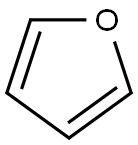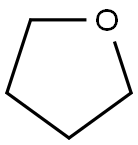Furan
- CAS No.
- 110-00-9
- Chemical Name:
- Furan
- Synonyms
- ACETYLFURAN;ACF;1-(2-FURANYL)ETHANONE;Pyrane;tetrol;Oxole;FEMA 3163;FURYL METHYL KETONE;OXOL;axole
- CBNumber:
- CB9852796
- Molecular Formula:
- C4H4O
Lewis structure
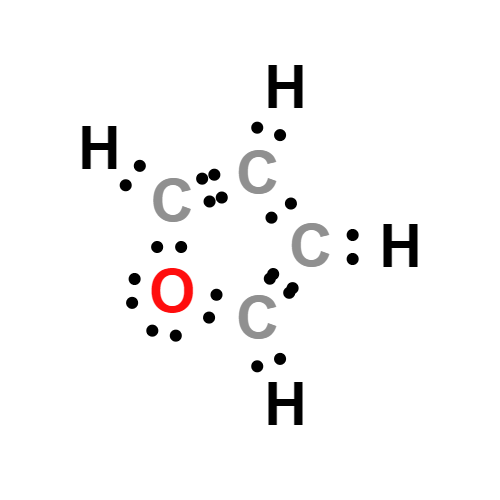
- Molecular Weight:
- 68.07
- MDL Number:
- MFCD00003222
- MOL File:
- 110-00-9.mol
- MSDS File:
- SDS
| Melting point | -85.6 °C |
|---|---|
| Boiling point | 67 °C10 mm Hg(lit.) |
| Density | 0.936 g/mL at 25 °C(lit.) |
| vapor density | 2.35 (vs air) |
| vapor pressure | 1672 mm Hg ( 55 °C) |
| refractive index |
n |
| Flash point | 160 °F |
| storage temp. | Store below +30°C. |
| solubility | alcohols: freely soluble |
| form | Liquid |
| color | Clear colorless to yellow |
| Odor | at 0.10?%?in?propylene glycol. ethereal |
| Odor Threshold | 9.9ppm |
| explosive limit | 2.3-14.3%(V) |
| Water Solubility | insoluble |
| Sensitive | Air & Light Sensitive |
| Merck | 14,4296 |
| BRN | 103221 |
| Dielectric constant | 3.0(25℃) |
| Exposure limits | NIOSH: IDLH 13 ppm |
| Stability | Stable. Substances to be avoided include strong oxidising agents, acids, peroxides and oxygen. Highly flammable; can form explosive mixtures with air. |
| InChIKey | YLQBMQCUIZJEEH-UHFFFAOYSA-N |
| LogP | 1.34 |
| CAS DataBase Reference | 110-00-9(CAS DataBase Reference) |
| EWG's Food Scores | 4 |
| NCI Dictionary of Cancer Terms | ACF |
| FDA UNII | UC0XV6A8N9 |
| Proposition 65 List | Furan |
| IARC | 2B (Vol. 63) 1995 |
| NIST Chemistry Reference | Furan(110-00-9) |
| EPA Substance Registry System | Furan (110-00-9) |
SAFETY
Risk and Safety Statements
| Symbol(GHS) |    GHS02,GHS07,GHS08 |
|||||||||
|---|---|---|---|---|---|---|---|---|---|---|
| Signal word | Danger | |||||||||
| Hazard statements | H224-H302+H332-H315-H341-H350-H373-H412 | |||||||||
| Precautionary statements | P210-P233-P273-P304+P340+P312-P308+P313-P403+P233 | |||||||||
| Hazard Codes | T,F+ | |||||||||
| Risk Statements | 45-12-19-20/22-38-48/22-52/53-68 | |||||||||
| Safety Statements | 53-45-61- | |||||||||
| RIDADR | UN 2811 6.1/PG 2 | |||||||||
| WGK Germany | 3 | |||||||||
| RTECS | OB3870000 | |||||||||
| F | 8-9-23 | |||||||||
| Autoignition Temperature | 390 °C | |||||||||
| TSCA | Yes | |||||||||
| HS Code | 2932 19 00 | |||||||||
| HazardClass | 3 | |||||||||
| PackingGroup | I | |||||||||
| Toxicity | LC (in air) in rats: 30400 ppm (Henderson) | |||||||||
| IDLA | 13 ppm (35.1 mg/m3) | |||||||||
| NFPA 704 |
|
Furan price More Price(22)
| Manufacturer | Product number | Product description | CAS number | Packaging | Price | Updated | Buy |
|---|---|---|---|---|---|---|---|
| Sigma-Aldrich | 8.20594 | Furan (stabilised) for synthesis | 110-00-9 | 250ML | $47.6 | 2024-03-01 | Buy |
| Sigma-Aldrich | 8.20594 | Furan (stabilised) for synthesis | 110-00-9 | 1L | $91.4 | 2024-03-01 | Buy |
| Sigma-Aldrich | 185922 | Furan ≥99% | 110-00-9 | 5ml | $34.5 | 2024-03-01 | Buy |
| Sigma-Aldrich | 185922 | Furan ≥99% | 110-00-9 | 100ml | $42.1 | 2024-03-01 | Buy |
| TCI Chemical | F0074 | Furan (stabilized with BHT) >99.0%(GC) | 110-00-9 | 25mL | $28 | 2024-03-01 | Buy |
Furan Chemical Properties,Uses,Production
Chemical Properties
Furan is the simplest five membered oxygen-containing heterocyclic compounds with its molecular structure containing ring diene ether. It belongs to 6π electron-based compound with all the 5 atoms being sp2-hybrid and located in the same plane. The pair of non-shared electrons of the oxygen atoms occupied p-orbital which is perpendicular to the ring plane and is parallel and overlapping with the p-orbital of the four carbons atoms, forming a five-atoms& six-electrons conjugated closed system. Therefore, it has a certain degree of aromatic nature. However, due to the electron density on the ring is not as uniform as benzene; it has a more active chemical property than benzene and can participate in many kinds of chemical reactions. It should be especially noted that, its 2, 5-position contains high electron density and prone to have nucleophilic substitution reaction. Moreover, all the derivatives of almost happens in 2-position such as furfural, furfuryl alcohol and furan carboxylic acid. Furan can also have nitrification, halogenated, sulfonated reaction. Its diene bonds can also participate in addition reaction, for example, have reaction with maleic anhydride, having diene addition reaction and generating 7-bicyclo-[2.2.1]-hept-5-ene-2, 3-dicarboxylic anhydride.
Under acidic condition, furan can have hydrolysis and ring open, producing 1, 4-dicarbonyl compounds. But once the furan ring has been introduced of electrophilic group, its activity can be greatly reduced and will not have diene reaction even encountering strong pro-diene compound. Although it contains certain aromatic property, but this property is very weak and there are no free hydroxyl furan or amino furan like phenol and aniline. When furan is subject to hydrogenation, it can give rise to two kinds of hydrides, namely dihydrofuran (2, 3-dihydrofuran and 2, 5-dihydrofuran) and tetrahydrofuran with the former being partially saturated cyclic enol ether and the later being saturated. Furan has a high thermal stability and is decomposed only at a temperature as high as 670 ℃ in the absence of catalyst. In the presence of a nickel catalyst, it is decomposed when heated to 360 ℃. This product is toxic and carcinogenic. The lethal concentration for Rat through oral administration is 300mg/kg. Its steam is narcotic which is similar as ether. It is easy to generate explosive peroxides in air.
Its steam encounters pine wood chip pre-soaked with hydrochloride tablets and generate green color (pine wood chip reaction). This can be used to identify the presence of furan.
The above information is edited by the chemicalbook of Dai Xiongfeng.
Raw material for organic synthesis
Furan is an important raw material in organic synthesis industry and can be used in the manufacture of many kinds of industrial chemical product such as pyrrole, thiophene tetrahydrofuran and benzofuran. It can also be applied to the manufacture of drugs such as anisodamine, atropine, toluoyl pyrrole sodium acetate, thiamine furan and furadantin and so on. Furan, through oxidation and polymerization, can generate conductive poly-furan polymer with the conductivity being 18S/m (use AsF5 as the oxidant) or 2.2 × 10-4S/m (with NOSbF6 as the oxidant). Furan is unstable and prone to be subject to oxidation and polymerization. Furan, via catalytic hydrogenation, can generate tetrahydrofuran.
Many furan derivatives are drugs such as furfural, furfuryl alcohol, furan carboxylic acid, nitrofurazone, furapromide and furosemide and so on. In some monosaccharides such as fructose and ribose as well as their derivatives, there exists the cyclic structure of hydrogenated furans.
Uses
It is primarily used for the adhesive for the production of large quantities of hot-box technological cores.
Furan can be used as the raw material of organic synthesis and solvents. Furan can also be used for preparation of pyrrole, thiophene and tetrahydrofuran. Tetrahydrofuran is an important derivative of furan with many important applications. Furan, when undergoes etherfication and reduction to give 2, 5-dimethoxy dihydrofuran which is further converted to 2-hydroxy-1, 4-butanedial through hydrolysis, can be used for the production of anisodamine via synthetic approach; When furan undergoes etherfication and reduction to give 2, 5-dimethoxy tetrahydrofuran and generate butanedial via hydrolysis, is the raw material for synthesis of another kind of alkaloid, atropine. Furan is also used to produce anti-inflammatory drugs toluoyl pyrrole sodium acetate with production of each ton of this product consuming 4.75 t of furan.
Production method
Furfural is oxidized into 2-furan formic acid which undergoes decarboxylation to obtain furans. Heat the 2-furan formic acid to 200-205 ℃ (around the boiling point) so it is decomposed into carbon dioxide and furans. During the reaction process, send the sublimated 2-furan formic acid back to the reactor with the distilled furan undergoing re-distillation; collect the distillation fraction of 31-34 ℃ which is the relative pure finished product with the overall yield being about 75%. Industrially, it can be obtained through direct decarbonylation of furfural. The catalyst used in the reaction includes aluminum silicate, metal oxides or hydroxides as well as the mixtures of alloy or metals such as the mixture of zinc chromite and manganese. The reaction temperature should be about 400 ℃ with the yield being 90%. For large-scale production, the yield can be 74%.
Category
Flammable liquid
Toxicity grading
poisoning
Acute toxicity
Inhalation-rat LC50: 3398 PPM/per hour; Inhalation-Mouse LC50: 120 mg/m3/per hour.
Explosive and Hazardous characteristics
Mixing with air can be explosive.
Flammability and hazard characteristics
It is flammable in case of fire, high temperature and oxidant with burning releasing irritated fume.
Storage characteristics
Treasury ventilation low-temperature and dry; store it separately from oxidants and acids.
Extinguishing agent
Dry powder, dry sand, carbon dioxide, foam, 1211 fire extinguishing agent
Professional Standards
TLV-TWA 0.5 mg/m3
Description
Furan occurs naturally in oils distilled from rosin containing pinewood. In addition, many natural foods contain the furan ring structure and substituted furans may be formed through cooking of simple carbohydrates. Furan is also found in tobacco smoke as well as wood smoke and gas emissions from gasoline and diesel engines. Furan has also been detected in industrial effluents and can be emitted to the air from petroleum refineries and coal-mining and gasification plants.
Chemical Properties
Furan is a colorless liquid; turns brown on standing. Strong ethereal odor.
Chemical Properties
Furan is a cyclic dienic ether stabilized by benzene-like resonance. Because of its conjugated unsaturation and heterocyclic atom, furan will undergo many types of reactions. It is, therefore, of interest as a chemical intermediate for pharmaceuticals, insecticides and fine chemicals. The heterocyclic oxygen atom in a ring with conjugated unsaturation gives furan a combination of ether, aromatic and olefinic characteristics. This polyfunctionality permits it to undergo a variety of reactions. Compared to benzene, the furan ring has greater reactivity, and is more susceptible to cleavage, thus resembling the vinyl ethers. Like the vinyl ethers, the furan ring is cleaved by aqueous acids. This reaction is accompanied by resinification .
Uses
Furan is a five-membered heterocyclic aromatic ring. Furan is used as a building block for the preparation of many heterocyclic compounds.
Uses
Furan is a valuable chemical intermediate for pharmaceuticals, insecticides, and other organic compounds. The furan ring is cleaved by aqueous acid which can lead to polymer formation.
Uses
Furan is used as an intermediate in organicsynthesis.
Uses
In organic syntheses.
Definition
furan: A colourless liquid compound,C4H4O; r.d. 0.94; m.p. –86°C;b.p. 31.4°C. It has a five-memberedring consisting of four CH2 groupsand one oxygen atom.
Definition
A heterocyclic liquid organic compound. Its five-membered ring contains four carbon atoms and one oxygen atom. The structure is characteristic of some monosaccharide sugars (furanoses).
Definition
A heterocyclic compound.
General Description
Furan is a stable, colourless chemical liquid. It is highly flammable and forms explosive mixtures with air. It is incompatible with many other chemical substances, for example, strong oxidising agents, acids, peroxides, and oxygen. Furan is produced commercially by decarbonylation of furfural. It is used mainly in the production of tetrahydrofuran, thiophene, and pyrrole. It also occurs naturally in certain woods and during the combustion of coal and is found in engine exhausts, wood smoke, and tobacco smoke.
Air & Water Reactions
Highly flammable. When uninhibited, Furan forms explosive peroxides on exposure to air. Insoluble in water.
Reactivity Profile
Furan is sensitive to heat and may turn brown upon standing. Furan may be light sensitive. When uninhibited, Furan forms explosive peroxides on exposure to air. Furan may react with oxidizers, acids, peroxides and oxygen. Furan resinifies on evaporation or when in contact with mineral acids, but Furan is stable in alkalis. .
Hazard
Flammable, dangerous fire risk, flammable limits 2–24%, forms peroxides on exposure to air. Absorbed by skin. Possible carcinogen.
Health Hazard
Furan is a highly toxic compound. Inhalationof its vapors can cause acute pulmonaryedema and lung damage. The intraperitonealLD50 value in rodents is between 5 and7 mg/kg. The inhalation LC50 value in micefor a 1-hour exposure is 120 mg/m3.
Health Hazard
The vapors are narcotic. Acute exposure to Furan by inhalation may involve both reversible and irreversible changes. Acute exposure by ingestion or skin absorption, as well as chronic exposure, are associated with high toxicity.
Fire Hazard
Very dangerous, upon exposure to heat or flame. Furan may form unstable peroxides on exposure to air. Contact with acids can initiate a violent, heat producing reaction. Avoid acids, oxidizing agents. Upon standing in air, Furan may form unstable peroxides.
Flammability and Explosibility
Extremely flammable
Safety Profile
Confirmed carcinogen. Poison by inhalation and intraperitoneal routes. Moderately toxic by ingestion and skin contact. Experimental reproductive effects. A narcotic. Mutation data reported. The exposure concentration limit of 10 ppm together with its low boiling point requires that adequate ventilation be provided in areas where ths chemical is handled. Contact with liquid must be avoided since this chemical can be absorbed through the skin. Washing thoroughly with soap and water followed by prolonged rinsing should be done immedlatelp after accidental contact. A very dangerous fire hazard when exposed to heat or flame; can react with oxidzing materials. Unstabdized, it may form unstable peroxides on exposure to air and should always be tested before ddlation. Washing with an aqueous solution of ferrous sulfate slightly acidified with sodum bisulfate will remove these peroxides. Confirm by test. Contact with acids can initiate a violent exothermic reaction. Moderate explosion hazard when exposed to flame. Furan's low bohg point makes it easy to obtain explosive concentrations of the vapor in inadequately ventilated areas. To fight fire, use CO2, dr). chemical. When heated to decomposition it emits acrid smoke and irritating fumes. See also PEROXIDES.
Potential Exposure
Furan is used as a chemical intermedi ate in the production of herbicides and pharmaceuticals; for making tetrahydrofuran; in formation of lacquers; as a sol vent for resins in organic synthesis, especially for pyrrole, thiophene.
First aid
If this chemical gets into the eyes, remove anycontact lenses at once and irrigate immediately for at least15 min, occasionally lifting upper and lower lids. Seek medical attention immediately. If this chemical contacts theskin, remove contaminated clothing and wash immediatelywith soap and water. Seek medical attention immediately. Ifthis chemical has been inhaled, remove from exposure,begin rescue breathing (using universal precautions, including resuscitation mask) if breathing has stopped and CPR ifheart action has stopped. Transfer promptly to a medicalfacility. When this chemical has been swallowed, get medical attention. Give large quantities of water and inducevomiting. Do not make an unconscious person vomit.Medical observation is recommended for 24-48 h afterbreathing overexposure, as pulmonary edema may bedelayed. As first aid for pulmonary edema, a doctor orauthorized paramedic may consider administering a corticosteroid spray.
Carcinogenicity
Furan is reasonably anticipated to be a human carcinogen based on sufficient evidence of carcinogenicity from studies in experimental animals.
Environmental Fate
Furan may be released to the environment as a waste industrial product or from unintentional or accidental releases. If released to soil, it is expected to volatilize. If released to water, furan is not expected to adsorb to suspended particles and sediment and is likely to volatilize to ambient air. Sulfate-reducing bacteria can degrade furan. However, under nonsulfate-reducing conditions, biodegradation in soil and water is expected to be slow. In the air, furan will exist as a vapor and will be subject to degradation by reacting with hydroxyl radicals.
storage
Color Code—Red: Flammability Hazard: Store ina flammable liquid storage area or approved cabinet awayfrom ignition sources and corrosive and reactive materials.Prior to working with this chemical you should be trainedon its proper handling and storage. Before entering confinedspace where this chemical may be present, check to makesure that an explosive concentration does not exist. Store inan explosion-proof refrigerator. Keep in a tightly closedcontainer under an inert atmosphere and protect from lightfor long-term storage. A regulated, marked area should beestablished where this chemical is handled, used, or storedin compliance with OSHA Standard 1910.1045.
Shipping
UN2389 Furan, Hazard Class: 3; Labels: 3-Flammable liquid.
Purification Methods
Shake it with aqueous 5% KOH, dry it with CaSO4 or Na2SO4, then distil it under nitrogen, from KOH or sodium, immediately before use. A trace of hydroquinone could be added as an inhibitor of oxidation. [Beilstein 17 H 27, 17 I 16, 17 II 34, 17/1 V 291.]
Toxicity evaluation
Furan can cause eye, skin, and mucus membrane irritation,
burning sensation and, in severe cases, corrosion. If inhaled,
furan may produce pulmonary edema and bronchiolar
necrosis. When absorbed, furan can cause central nervous
system (CNS) depression to the point of narcosis and tonic
seizures.
Furan is metabolized by the cytochrome P450 enzymes
in the liver and other tissues. Furan is metabolized to cis-2-
butene-1,4-dial. This active metabolite is acutely toxic to
liver cells. The furan ring undergoes oxidative cleavage and
forms highly reactive furan radical cations or epoxides,
which react directly with cellular nucleophiles. These reactive
metabolites may react directly with deoxyribonucleic acid
(DNA) or with cellular proteins to produce disruption of
cellular functions and cell death. Chronic cell death and
regeneration produced by chronic furan exposure may be
a significant factor in the carcinogenicity potential of the
chemical. In addition, there is some evidence to suggest that
the reactive metabolites of furan may induce mutations in
cellular genes.
Incompatibilities
May form explosive mixture with air. Incompatible with oxidizers (chlorates, nitrates, peroxides, permanganates, perchlorates, chlorine, bromine, fluorine, etc.); contact may cause fires or explosions. Keep away from alkaline materials, strong acids, amines, strong bases, reducing agents. Unless stabilized with an inhibitor, air exposure forms unstable peroxides.
Waste Disposal
Consult with environmental regulatory agencies for guidance on acceptable disposal practices. Generators of waste containing this contaminant (≥100 kg/mo) must conform with EPA regulations govern ing storage, transportation, treatment, and waste disposal.
Furan Preparation Products And Raw materials
Raw materials
Preparation Products
1of5
| Supplier | Tel | Country | ProdList | Advantage | |
|---|---|---|---|---|---|
| Hebei Kangcang new material Technology Co., LTD | +8619133911216 | Jany1001@kangcang.com.cn | China | 338 | 58 |
| Henan Tianfu Chemical Co.,Ltd. | +86-0371-55170693 +86-19937530512 | info@tianfuchem.com | China | 21695 | 55 |
| Jiangsu Qingquan Chemical Co., Ltd. | +86-571-86589381,86589382,86589383 | sales1@qqpharm.com | CHINA | 154 | 55 |
| SHANDONG ZHI SHANG CHEMICAL CO.LTD | +86 18953170293 | sales@sdzschem.com | China | 2931 | 58 |
| Hubei xin bonus chemical co. LTD | 86-13657291602 | linda@hubeijusheng.com | CHINA | 22968 | 58 |
| CONIER CHEM AND PHARMA LIMITED | +8618523575427 | sales@conier.com | China | 47465 | 58 |
| Shaanxi Dideu Medichem Co. Ltd | +86-29-87569265 +86-18612256290 | 1056@dideu.com | China | 3842 | 58 |
| SIMAGCHEM CORP | +86-13806087780 | sale@simagchem.com | China | 17367 | 58 |
| Career Henan Chemica Co | +86-0371-86658258 15093356674; | laboratory@coreychem.com | China | 30255 | 58 |
| Hefei TNJ Chemical Industry Co.,Ltd. | 0551-65418671 | sales@tnjchem.com | China | 34572 | 58 |
Related articles
- Electrophilic Reactions of Furan
- Furans are fairly soluble in organic solvents, including alcohol and ether, but slightly soluble in water. They are toxic and ....
- Jan 24,2022
- Uses of Furan
- Furan is a five-membered aromatic oxygen heterocycle, comprised of four conjugated carbon atoms and one oxygen atom in a cycli....
- Jan 24,2022
- Toxicity and hazards of Furan
- Furan can cause eye, skin, and mucus membrane irritation, burning sensation and, in severe cases, corrosion. If inhaled, furan....
- Oct 27,2021
Related Qustion
- Q:Furan in Foods
- A:Furan is a colorless, volatile liquid used in some chemical manufacturing industries. Furan has occasionally been reported to ....
- Sep 20,2019
View Lastest Price from Furan manufacturers
| Image | Update time | Product | Price | Min. Order | Purity | Supply Ability | Manufacturer | |
|---|---|---|---|---|---|---|---|---|
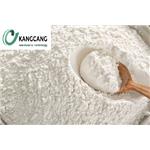 |
2024-04-18 | Furan
110-00-9
|
US $9.00-70.00 / g | 10g | 99% | 10 tons | Hebei Kangcang new material Technology Co., LTD | |
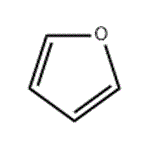 |
2023-07-27 | Furan
110-00-9
|
US $1.10 / g | 1g | 99.0% Min | 100 Tons | Shaanxi Didu New Materials Co. Ltd | |
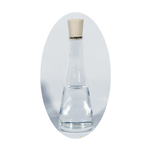 |
2023-06-26 | Furan
110-00-9
|
US $200.00 / kg | 1kg | 99% | 1000kg/Month | Hebei Mingeng Biotechnology Co., Ltd |





